
Acompsia is a genus of the twirler moth family (Gelechiidae). Though it has once been assigned to the proposed subfamily "Anacampsinae", it is generally placed in the Dichomeridinae. Some authors include Telephila here as a subgenus, while others prefer to keep it distinct as its relationships are fairly obscure.

Brachmia is a genus of the twirler moth family (Gelechiidae). Among these, it is mostly placed in the subfamily Dichomeridinae.

Bryotropha is a genus of the twirler moth family (Gelechiidae). Among these, it is placed in the tribe Anomologini of subfamily Gelechiinae; the tribe was formerly considered a distinct subfamily Anomologinae.
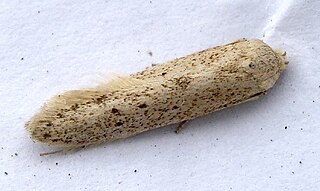
Blastobasis is the type genus of the gelechioid moth family Blastobasidae; in some arrangements these are placed in the case-bearer family (Coleophoridae) as a subfamily. Within the Blastobasidae, the subfamily Blastobasinae has been established to distinguish the Blastobasis lineage from the group around Holcocera, but the delimitation is not yet well-resolved.
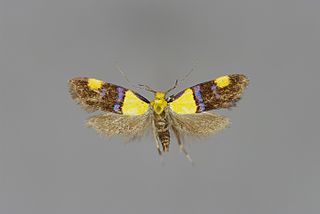
Oecophora bractella is a species of gelechioid moth. It belongs to the subfamily Oecophorinae of the concealer moth family (Oecophoridae). As the type species of its genus Oecophora, its affiliations and phylogeny determine the delimitation of that family and subfamily.

Alabonia geoffrella is a species of gelechioid moth. Here, it is placed within the subfamily Oecophorinae of the concealer moth family (Oecophoridae). Alternatively it has been placed in the Elachistidae or Depressariinae together with its presumed closest relatives.

Nemapogon is a genus of the fungus moth family, Tineidae. Therein, it belongs to the subfamily Nemapogoninae. As evident by its name, it is the type genus of its subfamily.

Nemaxera is a genus of the fungus moth family, Tineidae. Therein, it belongs to the subfamily Nemapogoninae. The genus is considered monotypic, with the single species Nemaxera betulinella placed here.

Monopis is a genus of the fungus moth family, Tineidae. Therein, it belongs to the nominate subfamily, Tineinae.

Esperia is a genus of the concealer moth family (Oecophoridae). Among these, it belongs to subfamily Oecophorinae. Most authors include Dasycera here, though approaches that generally follow a "splitting" approach sometimes do not.

Crassa is a genus of the concealer moth family (Oecophoridae). Among these, it belongs to subfamily Oecophorinae. The genus name Tichonia, established by J. Hübner in 1825, was frequently misapplied to these moths by earlier authors. But as the type species of Hübner's genus is the greenweed flat-body moth – originally described as Tinea atomella, but nowadays called Agonopterix atomella –, Tichonia is actually a junior synonym of Agonopterix. That genus does belong to the same superfamily as Crassa, but is placed in the concealer moth subfamily Depressariinae which is sometimes treated as distinct family.
Metalampra is a genus of the concealer moth family (Oecophoridae). Among these, it belongs to subfamily Oecophorinae. It was originally established as a subgenus of Borkhausenia.
Schiffermuelleria is a genus of gelechioid moths. It is placed in the subfamily Oecophorinae of family Oecophoridae. The genus is treated as monotypic, with the single species Schiffermuelleria schaefferella placed here. As such, its distinctness from the closely related genus Borkhausenia – where S. schaefferella was often placed in the past – is open to debate.

Tinea is a genus of the fungus moth family, Tineidae. Therein, it belongs to the subfamily Tineinae. As evident by its name, it is the type genus of its subfamily and family. Established as one of the first subgroups of "Phalaena", it used to contain many species of Tineidae that are nowadays placed in other genera, as well as a few moths nowadays placed elsewhere.

Luquetia is a moth genus of the superfamily Gelechioidea described by Patrice J.A. Leraut in 1991. It is mostly placed in the family Depressariidae, which is often – particularly in older treatments – considered a subfamily of the Oecophoridae or included in the Elachistidae.

Semioscopis is a moth genus of the superfamily Gelechioidea. It is placed in the subfamily Depressariinae, which is often – particularly in older treatments – considered a subfamily of the Oecophoridae or included in the Elachistidae.
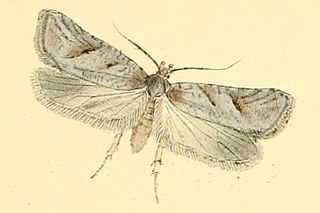
Exaeretia is a moth genus of the superfamily Gelechioidea. It is placed in the family Depressariidae, which is often – particularly in older treatments – considered a subfamily of Oecophoridae or included in the Elachistidae.
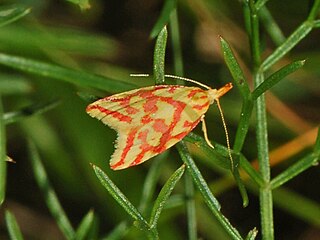
Hypercallia is a genus of gelechioid moths.

Levipalpus is a moth genus of the superfamily Gelechioidea. It is placed in the family Depressariidae, which is often – particularly in older treatments – considered a subfamily of the Oecophoridae or included in the Elachistidae.
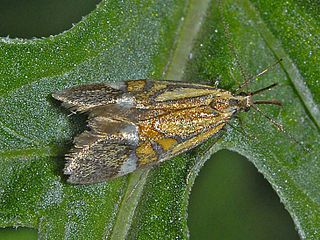
Alabonia staintoniella is a species of gelechioid moth. Here, it is placed within the subfamily Oecophorinae of the concealer moth family (Oecophoridae). Alternatively it has been placed in the Elachistidae or Depressariinae together with its presumed closest relatives.

















